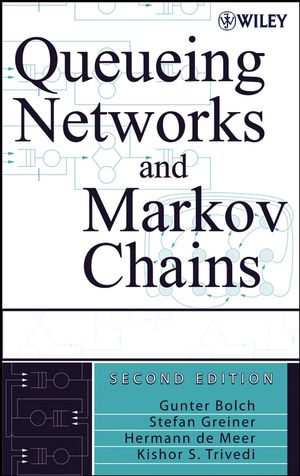Queueing Networks and Markov Chains: Modeling and Performance Evaluation with Computer Science Applications, 2nd EditionISBN: 978-0-471-56525-3
Hardcover
896 pages
April 2006
 |
||||||
Preface to the First Edition.
1. Introduction.
1.1 Motivation.
1.2 Methodological Background.
1.3 Basics of Probability and Statistics.
2. Markov Chains.
2.1 Markov Processes.
2.2 Performance Measures.
2.3 Generation Methods.
3. Steady-State Solutions of Markov Chains.
3.1 Solution for a Birth Death Process.
3.2 Matrix-Geometric Method: Quasi-Birth-Death Process.
3.3 Hessenberg Matrix: Non-Markovian Queues.
3.4 Numerical Solution: Direct Methods.
3.5 Numerical Solution: Iterative Methods.
3.6 Comparison of Numerical Solution Methods.
4. Steady-State Aggregation/Disaggregation Methods.
4.1 Courtois' Approximate Method.
4.2 Takahashi's Iterative Method.
5. Transient Solution of Markov Chains.
5.1 Transient Analysis Using Exact Methods.
5.2 Aggregation of Stiff Markov Chains.
6. Single Station Queueing Systems.
6.1 Notation.
6.2 Markovian Queues.
6.3 Non-Markovian Queues.
6.4 Priority Queues.
6.5 Asymmetric Queues.
6.6 Queues with Batch Service and Batch Arrivals.
6.7 Retrial Queues.
6.8 Special Classes of Point Arrival Processes.
7. Queueing Networks.
7.1 Definitions and Notation.
7.2 Performance Measures.
7.3 Product-Form Queueing Networks.
8. Algorithms for Product-Form Networks.
8.1 The Convolution Algorithm.
8.2 The Mean Value Analysis.
8.3 Flow Equivalent Server Method.
8.4 Summary.
9. Approximation Algorithms for Product-Form
Networks.
9.1 Approximations Based on the MVA.
9.2 Summation Method.
9.3 Bottapprox Method.
9.4 Bounds Analysis.
9.5 Summary.
10. Algorithms for Non-Product-Form Networks.
10.1 Nonexponential Distributions.
10.2 Different Service Times at FCFS Nodes.
10.3 Priority Networks.
10.4 Simultaneous Resource Possession.
10.5 Prograrns with Internal Concurrency.
10.6 Parallel Processing.
10.7 Networks with Asymmetric Nodes.
10.8 Networks with Blocking.
10.9 Networks with Batch Service.
11. Discrete-Event Simulation.
11.1 Introduction to Simulation.
11.2 Simulative or Analytic Solution?
11.3 Classification of Simulation Models.
11.4 Classification of Tools in DES.
11.5 The Role of Probability and Statistics in Simulation.
11.6 Applications.
12. Performance Analysis Tools.
12.1 PEPSY.
12.2 SPNP.
12. 3 MOSEL-2.
12.4 SHARPE.
12.5 Characteristics of Some Tools.
13. Applications.
13.1 Case Studies of Queueing Networks.
13.2 Case Studies of Markov Chains.
13.3 Case Studies of Hierarchical Models.
Glossary.
Bibliography.
Index.



